Steamship Captain Duties and Responsibilities - 1901
A Sea Captain's Day's Work
The Master Of A Transatlantic Liner - His Arduous Cares And Responsibilities -In Absolute Control Of A Great Vessel's Voyage Across The Sea With Two Thousand Souls On Board.
By Maximilian Foster
NOON -- and another day. As it goes ashore : a span of four-and-twenty hours -- two rounds of the clock divided into the details of even, ordinary life. The day swings by, rest, labor, and recreation have their allotted turn, all in order as ordained.
But here upon the sea 'tis different. Four-and-twenty hours that slip by lazily, perhaps; calm seas that reflect the blueness of the open sky, or --
There is the other side : four-and-twenty hours that drag along, each freighted with a heavy care; anxious hours of peril when the life of the ship and the safety of perhaps two thousand souls weigh gravely upon the mind. In the day's work of a liner captain are many views of life.

Captain Berends of the Transatlantic Steamship SS Auguste Victoria of the Hamburg America Line. GGA Image ID # 12e0a9f329
His task is large. Here, now, is one of the modern fliers, a hull of fifteen thousand tons or more, peopled fore and aft. Five hundred souls are in the cabin, eight hundred in the steerage, and through the ship her working force, perhaps four hundred more. On one man's shoulders, after all is done, rests the burden of responsibility and care.
He is the director, the adviser, of the great fabric, the head of this veritable village flying, full-powered, from coast to coast. All aboard appeal to him, but he must hold counsel with himself alone. There is none for him to fall back upon if peril comes and disaster stalks upon the sea.
Noon -- one ship's-day gone and another begun. Around lies the dead, gray fog -- a dull vapor, reeking of the salty sea, and blinding the liner as she noses onward along the course. Here from the bridge you see only the shifting veil that lies on every side, baffling the eye and killing the sense of hearing.
Forward, the bows end bluntly in that wall of mist whose streamers swirl eddying along her flanks as she forges through the gloom. For an instant, overhead, the sun shows, a coppery ball striving through the gray vapor. In the starboard wing of the bridge -- she is eastward bound -- the captain stands; beside him, an officer with the sextant.
Noon -- a chronometer ticks the second of the hour. Upward points the sextant, an anxious eye peering through the flying mist. " Got it ? " the captain murmurs, and the other nods. And now, for the first time, perhaps, in thirty or forty hours, will be shown their exact position upon this blank, solemn waste of sea.
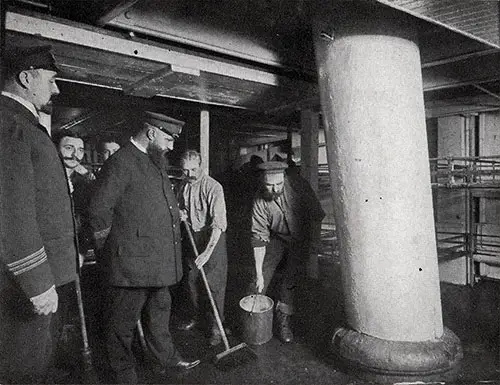
Captain Berends Observes the Cleaning Up In the Steerage. GGA Image ID # 12e0c1f231
Once more another cloud of the fog-bank drives across the zenith, and the red sun is gone. The whistle blares, a choking blast, and forward a bell beats the hour of day -- eight strokes -- each a startling noise breaking through the silent fog. The ship's-day has begun.
The captain and his aide quit the bridge. As he drops down the companion, he casts one quick glance right and left about. There is the quartermaster at the wheel, the junior officers at their appointed posts, both in easy reach of the bridge telegraph -- ready at a moment to flash a signal to the engine-hold below. Onward drives the ship, her engines slowed a turn or so, yet still at a flying gait and bound to make her schedule time.
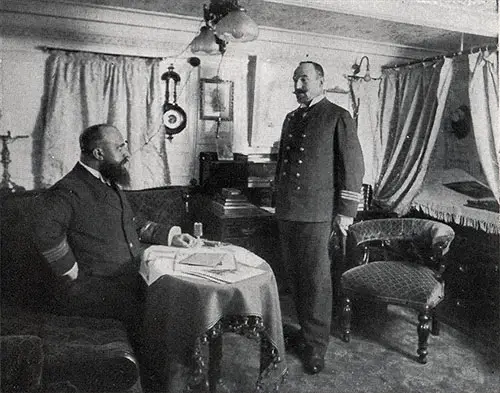
The Chief Officer Gives His Report to Captain Berends. GGA Image ID # 12e11a8523
Below -- underneath the bridge -- is the chart-room, a square cuddy, filled with charts of sea and shore, lighted forward with broad panels of glass that look out, forward and at the sides, on three-quarters of the sea. On the center table lies the ocean chart, ruled with the course, and the narrow lanes of east- and west-bound traffic.
Flights of arrows -- the ocean currents -- are marked upon its face; numerals in broken columns fix the soundings -- wherever soundings are, -- and penciled lines, marked at the ends with dots, show her run thus far across the sea.
They stretch the chart before them, and take the sextant reading. Minutes of silence pass, the men in creaking oilskins poring over their work, each figuring with exactness and pains, with the zealous care of a bank-clerk. Then they end; the result is read; they compare figures, each scrutinizing the other's work.
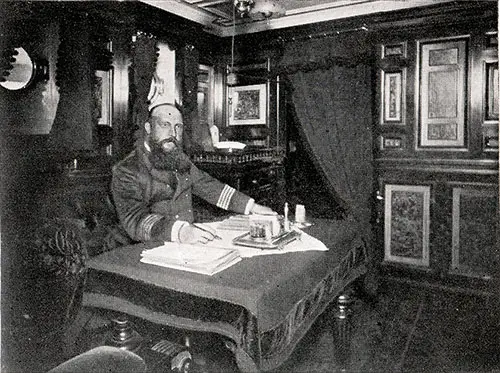
The Captain in His Quarters on Board the SS Augusta Victoria. GGA Image ID # 12e17fba81
" Morning, chief," the captain greets, as the chief engineer comes in. He brings the engine's cards, the record of its work -- scores that tell to a turn the revolutions of the screws. With a clouded sun they must fall back on these, to find by them a dead reckoning of her place.
Below the giant power is heaving at its toil, the strength of fifteen thousand horses leashed to the threshing screws. Stroke by stroke the engines fling about, the thudding cranks flying in their orbits, strenuous, yet docile as a child, answering to the lightest touch that gives or takes their steam. " All's well," reports the chief, and goes below.
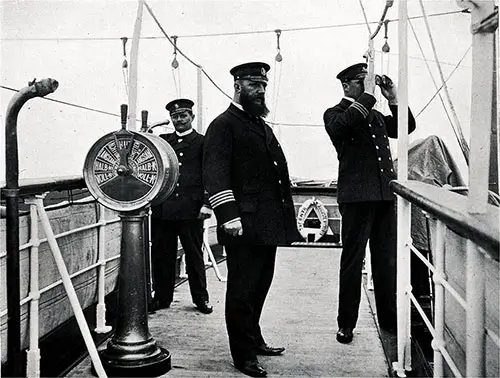
Officers on the Bridge of the SS Augusta Victoria. Captain Berends and Chief Officer Are Watching a Passing Ship. GGA Image ID # 12e1f17d52
The ship's run is reckoned, her position marked upon the chart. The penciled dot falls in the midst of the meteoric arrows, symbols that show the current leading down from Arctic seas.
The ship is on the southern course, a good bit below the usual track of berg and floe, hard perils of the North Atlantic trade; but even here there may be some stray wanderer out of the Arctic north, and a liner captain takes no risk.
Again to the bridge : the junior officers are at their posts, their eyes strained forward, each pressing in his eagerness hard against the weather-cloths spread from rail to stanchion.
A sharp blast drives down from the windward quarter, harping for an instant among the standing rigging. It is cold -- perceptibly grows colder. The mercury is falling; the sea thermometer, drawn from below, shows the water chilling, too. "Ice ! " they say sententiously.
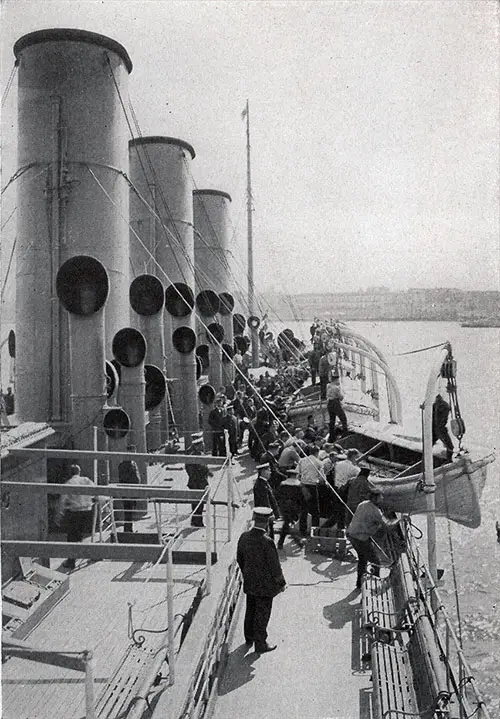
The Lifeboat Drill. GGA Image ID # 12e26642f9
Yet still the ship drives on. Word passes forward to the lookout, for sharp eyes now are needed there. Two watchers are by the bows; another in the crow's-nest up aloft. Slow down, you say?
No -- there are mails aboard, and passengers hurrying from port to port. Time counts, and a ship that fails in her schedules loses favor all around. So through fog, high seas, and driving gale, the liners keep their way, halting only in the face of peril, and turning from their courses only in the face of imminent disaster.
The fog shuts in, a thicker pall. The ship's bows drive deeper into the mist; the whistle blares, hooting, deep-chested, with a deafening crash. Between the warning blasts there is silence on the bridge, and forward stands the master, the moisture dripping from his brow and beard.
Once more, a raw gust flares across, touching coldly, like a hand of death, upon the straining faces. Instinctively they all turn toward the captain. His hand lifts -- " Slow down," says he.
At a touch the pointers on the dials bear over; the gongs of the bridge telegraph clatter sharply to the answer from the engine-hold below, and the tread of the machinery changes. Then as the hum of the bells dies down, a hoarse shout from the forward lookout follows :
" Ice -- dead ahead ! "
A sharp commotion fills the bridge. An order raps along :
" Starboard your helm -- hard down ! Full speed ahead on the port engine -- astern a-starboard !"
No time now to go full speed astern; they could not check her way.
The gongs beat their frantic measure. Silence follows. For an instant then, they hear the sound of the sea breaking as upon an iron coast. A tall shadow uprears in the mist, the dim outline of peaks and spires.
Shout follows shout from the lookouts by the bow; the fog splits asunder. There -- see -- under her bows almost, an over towering cliff up rears -- a cathedral of ice, a heavy base rising to pinnacles, all of deepest blue.
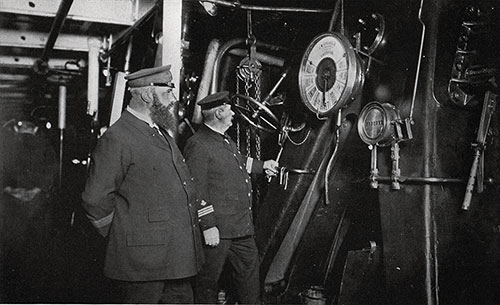
Below Deck in the Engine Hold. The Captain Conferring With the Chief Engineer. GGA Image ID # 12e27f1273
Harshly, the waves ply against its flanks, and a giant tremor falls upon the ship, quivering fore and aft under the strokes of the contending screws. Then her head pays off; she draws from the impending doom, slips by so close that one may peer into caves and valleys of the berg; and the fog shuts down anew.
The ship sheers off, her whistle hooting as in terror. Behind lies the disaster-bringing stray of the North, lost again in the choking fog. Another signal sounds upon the bridge; the shocking of the screws dies down. Her helm is turned, she points upward on her course and, at three-quarters speed, again goes driving on her way.
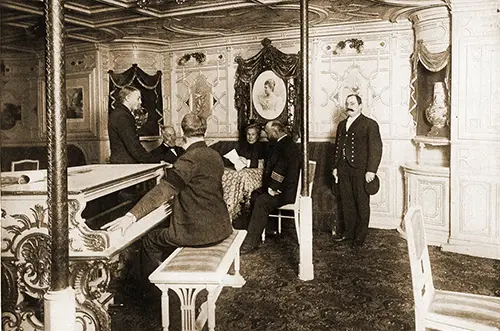
Chief Officers in the Music Room Looking Over the Ship's Concert Program. GGA Image ID # 12e2affcfe
" Touch and go," mutters a voice, speaking as in a dream.
Another watch gone by. Overhead, the sky lightens, and there is a crisp promise in the wind. Forward, a rift opens in the bank, a narrow lane, where the sea heaves like a lake of oil, hardly ruffled by the gusts that sweep beneath the edge of the vapor sheets. "She's lifting," one of the juniors says, but with the words still in his mouth, the fog draws in again, and drives along the rail.
Then, as before, again the vapor rises, and a broad stretch of open water lies beyond, a clear sea, and there, close in upon her lee, a straggling fleet of Gloucester craft hanging at their anchors.
One lies hard aboard; so near that you can stare down on her upturned deck, filled with its chaos of tackle and nests of dories stowed along the rail. A wild clamor of horn and bell greets the liner as she pokes out from the fog, and the rails are lined as she picks her way through the press of fishing craft.
One by one they drop astern; again the fog bank settles, and so -- open and shut throughout the watch -- the ship fares on till, with a sudden puff, the vapor lifts aloft, and the westering sun shoots a fiery light across the wide expanse of sea.
" Full speed " -- the order passes; and once more she is tilting her way, the voice of the engines below rising in the song of haste and steam.
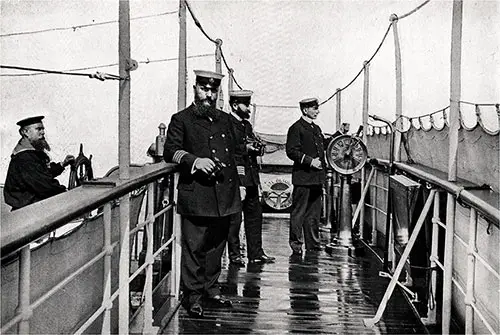
Officers on the Bridge after the Storm. GGA Image ID # 12e2d55c9d
This is the mid-Atlantic. Yet on every side are plying sail. Astern, the fishing craft dot the ocean's edges, and in the southern quarter, an east-bound tramp, astray through the mist, has wandered far from her rightful course.
On the western rim of the visible sea, a Norwegian bark, deep-laden, bends to the rising breeze, and farther on is a smudge of smoke from some other liner's stacks. It is even here a crowded course, and so even on the widest sea one must pick a way.
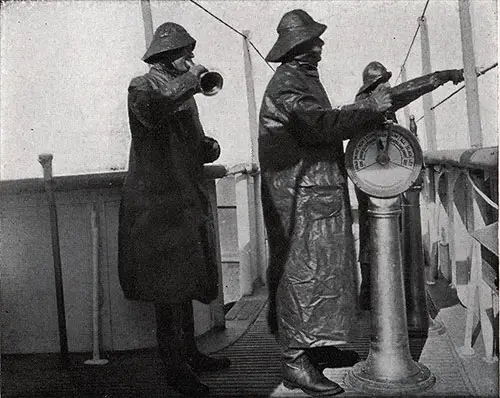
Maintaining the Course in Thick Weather. GGA Image ID # 12e3752061
There is no slap-dash rushing from coast to coast in the trans-Atlantic trade. High speed is the rule, of course. But few outside the trade know or can understand the care under which these liners fly from port to port. What if by chance -- a dire chance, indeed -- some hull should go tilting in the fog against the flank of one of these deep-sea fliers?
Such things occur, but they are few and far between. Even then the liner captains know their work, and the fair-weather boat-drill is not altogether for show, nor to interest the saloon.
Once more, now, a clear sea stretches around the ship. In the west, the sun is drawing down to the clean rim of the skyline, and night is near at hand. One last look about, and the captain starts below.
For these last thirty hours or more he has stood upon the bridge to have and to hold in his grasp the care of the ship and all the lives aboard. His anxieties, now, for a moment are at rest.
The course is given; the watches changed. " I'll turn in for a nap -- call me if I'm needed," he warns the watching men.
But sleep, for a man weary with his cares, is a tricky thing. Perhaps an hour's restless turning, or a time of heavy slumber. Then the call for dinner sounds; he arises wearily, yet with a cheerful face takes his place at table.
In these days the blunt bad manners of the old Atlantic trade are seen no more. The captain is the host of his ship, amiable and agreeable, but as a rule keeping to himself in hours of duty.
At the table he unbends, perhaps, but at all times his courtesy is expected. So for a half hour, now, he chats with those at his right and left, and with a bow, withdraws.
The night has fallen. A strong wind strikes its note among the standing rigging, and far down the horizon is a bank of clouds. A minute the tired man leans against the rail, staring around upon the sea, marks the distant cloud-bank lighted by the rising moon, and with a long breath walks into the chart-room for a look at the glass. It marks an approaching blow. He notes the change, and once more mounts to the bridge.
Blind squalls of rain drive in procession across the sea, and spray strikes hissing upon the weather cloths along the bridge. Stiffly, the big liner rises to the crest of a running wave, and slips down, snoring through the valley beyond. Then, with a plunge -- her head tossing off the weight -- she climbs again, and so on through the gloom plunges to the westward.
The night glasses pore through the murk ahead. A squall goes by; a dim shadow rises on the deep. " Hard a-port " a sharp voice cries along the bridge, and the wheel flies spinning over.
There -- just ahead -- a ghostly fabric starts from the sea; underneath a dark hull, and above a pinnacle of flapping cloth, as the stranger, dismayed, flies up into the wind. In hasty alarm the liner sheers away, slipping past the ship that lies there, her sails fluttering like the pinions of a frightened bird. Then she is gone again, lost in the dark astern.
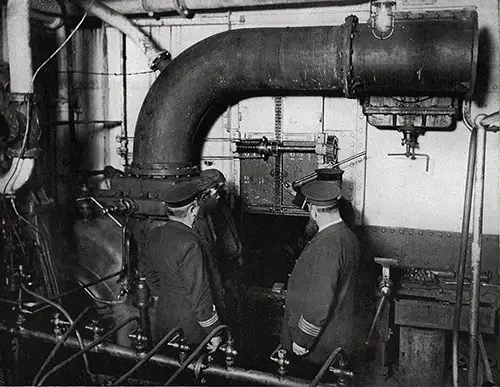
Testing the Bulkhead Doors. At Sea, the Captain Is Required to Make Sure That They Are Always in Working Order. GGA Image ID # 12e38e9958
Throughout the night, he stands at his post, the master in command. Then dawn rises, the storm blows by, and the glorious sun shoots above the sea. There is still a stiff sea running, but this and the wet decks are the only traces of the night's foul weather; and, worn out, the captain resigns his watch, and once more seeks his broken rest.
The morning wanes; again he appears. Once more to the bridge where the watch reports, a slim account of details since the storm went by. For facility's sake, the captain breakfasts there -- a cup of coffee and a sandwich. Then it is half-past ten, and a new feature of his life appears, a thing that shows the multiplicity of his cares.
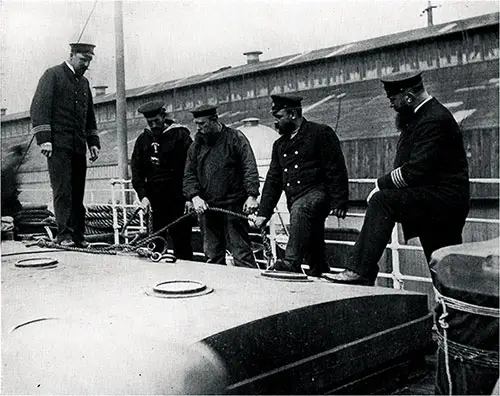
Captain Berends Inspects the Deck of the SS Augusta Victoria with Senior Officers and Staff. GGA Image ID # 12e413ced3
Below, the chiefs of the divisions wait -- the chief officer, purser, doctor, and head steward. Ship has been cleaned for the day, and the master, like a housewife, must make sure that all is neatness and order.
Followed by his staff he walks along, looking through all the gangways and along the decks, viewing the cabins, a few moments in the music room, a few more in the saloons.
He sits for an instant while his work waits, scanning the program of the inevitable concert -- the entertainment in aid of seamen's charities. Then on again, a peep into the staterooms, a brief but thorough inspection of the fire hose and apparatus.
His journey carries him on; he must see to every cabin, forward and aft, the saloons and the steerage. He must satisfy himself that all is clean and shipshape, that the saloons are spic and span, that the steerage is thoroughly scrubbed.
He climbs about the striving engines, glances at the dials, and goes on. The bulkheads next engage him. Once a day, at least, all that are open at sea must be tried for safety's sake. If fog, wind, or sea keeps the captain on the bridge, he must make sure that others have looked to the work.
Here, to-day, he inspects it all himself, sees that the men are at their appointed posts, that the bulkhead doors work smoothly without a hitch. Then, aloft again, a slow march around the decks thronged with the life of the ship, and all secure in safety. He stops here and there, chatting with the passengers that engage him, and once more mounts to the bridge.
It is noon -- noon and another day in the life at sea. Thus the round goes on.
Foster, Maximilian "A Sea Captain's Day's Work: The Master Of A Transatlantic Liner - His Arduous Cares And Responsibilities -In Absolute Control Of A Great Vessel's Voyage Across The Sea With Two Thousand Souls On Board.", World's Work Magazine, April 1901, Pages 631 - 639.
